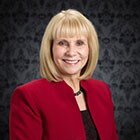
Suzanne Ketchem
Senior Director of the Women & Children’s Service Line, UCHealth in northern Colorado, USA. Past National President (2016) of the Association of Women’s Health, Obstetric and Neonatal Nurses (AWHONN), and active member of the American Organization of Nurse Executives (AONE) and Colorado Organization of Nurse Leaders (CONL)
1. How have advances in technology changed the way you work? In terms of improving my work, I’d love to see technology become more invisible. I need accurate data, of course, but I don’t want to feel like the equipment is coming between me as the nurse and the patient I am caring for during labor and birth. We’re definitely on the right track here too.
When I began my career as an obstetrical nurse 35 years ago, childbirth was considered a medical procedure. Back then, the patient was admitted to a sparsely decorated labor room with only a bed, night stand and clock. Maternal-fetal assessments were done by auscultation and palpation using a Doppler or fetoscope unless the mother was identified as high-risk or receiving Pitocin for induction or augmentation of labor; in those cases, we used electronic maternal/fetal surveillance monitoring. Patients were only allowed to ambulate to the bathroom, and only one support person – usually the father – could be in the room with them during labor.
Today, it’s a completely different story. Mothers and their babies are monitored using palpation and auscultation or electronic maternal/fetal surveillance throughout labor and so we can keep a closer eye on them – even when we’re not physically in the room. Additionally, moms are encouraged to move around as often as they desire, take a bath, and assume whichever position is comfortable for them. And because of the incredible advances in technology, we can still monitor them continuously. We also work far more collaboratively today. Everyone has access to the same data, so we can share and discuss the patient’s plan of care in multi-disciplinary teams of midwives, nurses and physicians, and make more informed decisions. Ultimately, this helps support superior patient care and satisfaction with the birth experience.
2. Which developments have surprised you the most during your time in the field of obstetrical care?
I am very excited about the developments in prenatal care and monitoring – some of the advances have really taken me by surprise. First-trimester ultrasound scanning is an important tool in providing high-resolution images of internal fetal anatomy structural development. We can screen for metabolic and genetic abnormalities in the second trimester, giving the provider more information that can be relayed to the mother and family, and helping guide them in making more informed decisions regarding their pregnancy and baby. Fetal surgery is a growing branch of maternal-fetal medicine that covers a broad range of surgical techniques that are used to treat birth defects in fetuses who are still in the pregnant uterus. Years ago, I would have never imagined these things were possible.
3. How has the labor experience evolved from the mother’s perspective?
It’s changed immensely. In the past, we’d talk passively about ‘delivering a woman of her baby’; the doctors would make the decisions, the nurses would follow their orders, and the woman’s wishes and requests were not considered by the doctor. Today, mothers are highly informed about their choices and come with expectations and birth plans that are followed by the care team to the best of their ability. Additionally, there are so many more birthing options available to the mother, including alternative locations and positions. The entire care team works hard to accommodate the mothers’ wishes and to make the entire birth experience as flexible as possible.
4. How have public and clinical attitudes changed with respect to mobility in labor?
We have realized that being confined to a bed is simply not the best way to go through labor. This mind shift was initially driven by the mothers themselves who started saying: “But it feels better to be moving around.” And thanks to evidence-based research and education, we know that they are absolutely right. In the past, we might have been reluctant to let them out of our sight, but with the wireless monitoring technology we have today, we’re happy to let them move around the entire unit freely, because we can still keep track of both mom and baby.
5. What future advances would you like to see in the field of labor and delivery that would improve your job or the mother’s experience?
I would like to see further advances that support the idea of birth as a natural process rather than a medical intervention. We’ve definitely started on the right path and I’d like to see this continue. What’s more, I would welcome technologies that support the birthing experience as an inclusive, multi-disciplinary event – supporting collaboration and involvement of everyone, including the moms.
